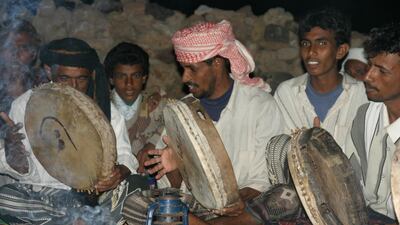Recently, I spent an evening on the remote Yemeni island of Socotra, listening to the annual poetry competition. Supported by the UAE's Sheikh Khalifa Humanitarian Foundation, the event allows the island's top poets to showcase their skills in Socotri, one of a number of modern South Arabian languages, whose origins predate today's Arabic.
Little studied and without an agreed alphabet, they exist in oral form only, representing a major threat to their long-term survival.
Socotri is spoken or understood by most of the people on the island, with around 70,000 speakers. All but one of the other five languages in the group, found in Oman's Jiddat al-Harasis and Dhofar regions or the adjacent Mahra governorate of Yemen, have far fewer. Only around a dozen people on Oman's south-east coast still fluently speak Bathari
Unesco has designated this year as the International Year of Indigenous Languages, which seeks to raise awareness of and to protect those in danger of disappearing. According to the Endangered Languages Project, established by a global consortium of linguists, there are approximately 7,000 existing languages in the world. Unesco estimates that around 2,680 are in danger of disappearing. Nearly 500 are already considered extinct.
As languages vanish, a wealth of knowledge and cultural diversity disappears with them.
There are, however, steps that can be taken to help them to survive. The Socotri poetry festival is one, while work is under way to agree upon an alphabet that will allow the language to be taught formally in the island’s schools.
In my other home, the British Channel Island of Jersey, Jerriais is descended from the language developed by Viking settlers more than 1,000 years ago. It has recently been declared the third official language in the island's States Assembly, along with English and French, as part of steps to encourage people – particularly the young – to learn and to use it. The native speakers I remember from my youth have long since passed away.
These are initiatives that may help to ensure the survival and continued relevance of these threatened tongues.
Here in the Emirates, we only have one native language, Arabic. There is, however, or was, great diversity within the Arabic spoken here, with different dialects and vocabularies that are in danger of dying out. They contain not just knowledge of the way in which people interacted with the environment around them but also the forgotten impacts of neighbouring civilisations and peoples.
Many years ago, a Palestinian friend of mine told me that he had needed an interpreter when he first visited the Liwa Oasis, because he simply couldn’t understand a lot of the words that were being used.
Another example: as part of my studies of local birdlife, I once started collecting the local names of familiar species. I found that there were often variations, with one name being used in western Abu Dhabi and something completely different on the UAE’s east coast. I never got far enough with the research to investigate the origins of the different names, let alone how widely they were spread, but there is, I am sure, considerable scope for detailed studies on this field.
In recent times, new words have come into use in local dialects of Arabic, reflecting the impact of development. A “draywel”, for example, is simply a corruption of the English word “driver”. “Bidfud”, a word to describe a truck that I haven’t heard for years, is a corruption of “Bedford”, the British manufacturers of many of the first trucks to reach the Emirates a few decades ago. The “bani heiss”, another vanished term that may originally have emerged in Aden, means the “ice men”, who used to travel around selling blocks of ice in the years before the arrival of refrigerators and a reliable electricity supply.
Through teachers, books and films from elsewhere in the Arabic-speaking world, other terms have entered into conventional spoken Emirati Arabic, helping to push out words that may have owed their origins to the languages spoken here before the development of Arabic or to the arrival of peoples from elsewhere. Other threatened words will reflect the traditions and practices of the shipping of times past or the interaction of Emirati sailors with ports and languages from East Africa to South-east Asia.
The process by which such terms entered into our language also reflects an underlying adaptability in Emirati society that is particularly relevant in this Year of Tolerance.
Languages are, of course, not static: they evolve, creating new terms to cope with modern innovations or adopting new words from other tongues. For languages such as English or modern Arabic, there is a literature dating back centuries that allows us to see just how much they have changed.
For the endangered modern South Arabian languages and for the traditional dialects of the Emirates, there is no such ancient resource. It is all the more important, therefore, that they are recorded and studied before, perhaps almost inevitably, they fade away.
Peter Hellyer is a consultant specialising in the UAE’s history and culture


